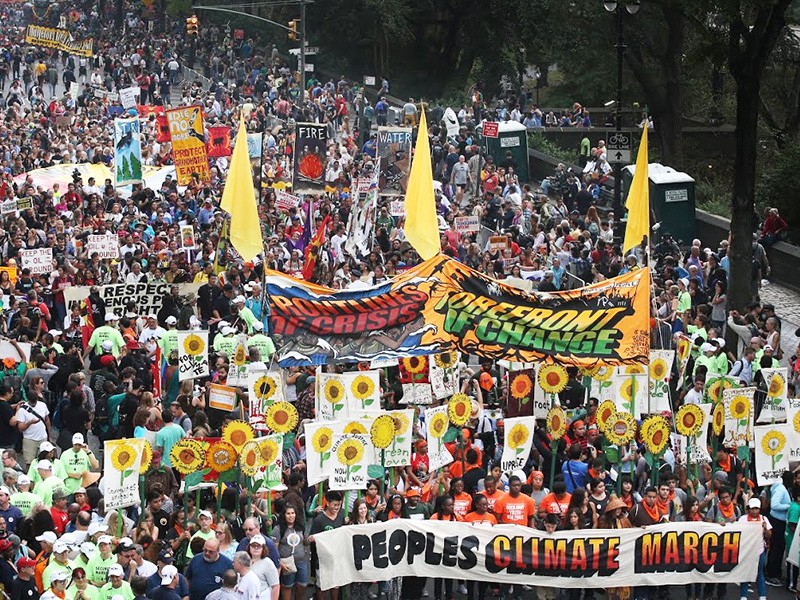WHERE WILL THE MONEY COME FROM?

Photo: Peoples-Climate-March-NYC-20140921-Will-Davies-AP-800.jpg - used with permission from www.russvernonjones.org

When I was young, I wanted the things that my friends had – a bicycle, money to spend on candy, a few days at the beach. “We can’t afford it,” was what I heard from my beleaguered parents. We were poor enough that this was often an honest answer. Occasionally, I think they used it as an excuse when they really didn’t want me to have something. As I got a little older, I mostly stopped asking for anything that seemed expensive. I already knew the answer, and I didn’t want to embarrass or fight with my parents.
“We can’t afford it,” is what we are often told now when we want better schools, reliable mass transit, healthcare, or updated infrastructure. It is certainly what many of us hear when we want 100 percent renewable electricity, or net zero-energy buildings, or a just transition for workers out of the fossil fuel industries which we need to close down promptly. It’s what some of us are hearing when we want our city or town to put solar panels over the high school parking lots.
Can We Afford It?
Can we afford it? Can we afford a full and prompt transition to a sustainable economy – including generating electricity, heating and cooling our buildings, and providing transportation without using fossil fuels? Clearly it’s going to take massive investment and expenditures to do everything that we must do in the coming decades to avoid complete climate catastrophe. One estimate is that the world will need between $1 trillion and $2.5 trillion per year for a sustained period, which is around 2 percent of world GDP. Is it realistic to think that is possible? Yes. Not easily, and not without considerable disruption of business as usual, but it is possible. Here are a few of the perspectives that I use to draw that conclusion.
It’s Cheaper to Do It Than Not to Do It
Project Drawdown calculates that it will require additional expenditures of roughly $27 trillion to implement their top 80 climate solutions over the next 30 years. But when they calculated the net operating savings from implementing those solutions it came to $74 trillion over 30 years! Doing what we need to do to stop making climate change worse is going to be expensive, but it will save us money in the long run. Not doing it is going to be way more expensive than doing it.
In the U.S.
In recent years the United States has spent trillions of dollars on wars, bank bailouts, and tax cuts for the rich, without any new taxes or triggering inflation. The federal government has a tremendous capacity to invest and spend when it wants to. The argument that we can’t afford it is a political fiction created to shift wealth to the already-rich, rather than fund the common good. Furthermore, the public investments and expenditures envisioned by the Green New Deal will stimulate the economy, generate increased jobs and income for millions of people, build a green economy, and increase tax revenues without increasing tax rates.
Worldwide
While all of the above is true, those dynamics will not generate sufficient funds for the worldwide elimination of greenhouse gas emissions, increased sequestration of carbon, and development to meet the basic needs of the world’s population. We cannot, and should not, expect the less-developed nations to put off developing the ability to meet the needs of their people. We developed by burning fossil fuels. We need them to develop without relying on fossil fuels. They will need help to develop in ways that don’t worsen global climate change, and also help us deal with the horrific effects of the climate change we have caused.
Where is the money?
Where will this money come from? To answer that question, we must first ask, where is the money now? The big money is in the hands of very wealthy individuals and families. Worldwide, the wealthiest 1 percent now own more than half the wealth of the world. Total world wealth is currently about $317 trillion. In the United States, the top 1 percent now own 40 percent of the wealth of the nation and the top 1 percent in the US own more wealth than the bottom 90 percent combined. The top 10 percent of households in the US own 70 percent of the nation’s wealth. They own a bigger share of the nation’s wealth than at any time in the last 50 years.
This obscene inequality cannot be ignored when we face an existential crisis. The wealthy have been getting richer, while most others have been getting poorer or struggling to stay even. The wealthy have been taking a larger and larger share of the wealth created by the hard work, intelligence, and creativity of all of the rest of us. They have not been paying their fair share of the costs of providing for the common good or of creating a sustainable economy for everyone.
The Military Budget
The other place that there is a lot of money is in the U.S military budget. Actual “defense” spending is between $1 trillion and $1.25 trillion dollars per year. The U.S. military budget accounts for 54 percent of all discretionary spending in the federal budget and is larger than the next seven highest military budgets in the world combined. The U.S. military also has a huge carbon footprint, causing serious damage to the climate.
Conclusion
Can we pay for transitioning to a sustainable U.S. and world economy without making working people foot the bill? Yes!
Will we? That will depend on how powerful a people’s movement we build.
Russ Vernon Jones blogs regularly on climate justice at www.RussVernonJones.org .
